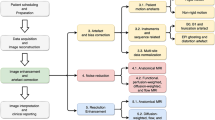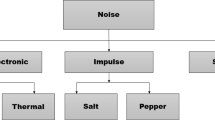Abstract
Medical image registration plays a dominant role in medical image analysis and clinical research. In this paper, we present a new coarse-to-fine method based on pulse-coupled neural networks (PCNNs) and mutual information (MI). In the coarse-registration process, we use the PCNN-clusters’ invariant characteristics of translation, rotation and distortion to get the coarse parameters. And the parameters of the PCNN model are optimized by ant colony optimization algorithm. In the fine-registration process, the coarse parameters provide a near-optimal initial solution. Based on this, the fine-tuning process is implemented by mutual information using the particle swarm optimization algorithm to search the optimal parameters. For the purpose of proving the proposed method can deal with medical image registration automatically, the experiments are carried out on MR and CT images. The comparative experiments on MI-based and SIFT-based methods for medical image registration show that the proposed method achieves higher performance in accuracy.





Similar content being viewed by others
References
Yang YF, Yang H, Su ZX (2012) Medical images registration method integrating features and multiscale information. Advances in future computer and control systems. Springer, Berlin, pp 653–658
Rueckert D, Schnabel JA (2011) Medical image registration. Biomedical image processing. Springer, Berlin, pp 131–154
Yanping S (2013) Review of image registration methods for medical images. Chin J Med Phys 1:014
Oliveira FP, Tavares JMR (2014) Medical image registration: a review. Comput Methods Biomech Biomed Eng 17(2):73–93
Valsecchi A, Damas S, Santamaria J (2013) Evolutionary intensity-based medical image registration: a review. Curr Med Imaging Rev 9(4):283–297
Lowe DG (2004) Distinctive image features from scale-invariant keypoints. Int J Comput Vis 60(2):91–110
Maes F, Collignon A, Vandermeulen D et al (1997) Multimodality image registration by maximization of mutual information. IEEE Trans Med Imaging 16(2):187–198
Wachowiak MP, Smolikova R et al (2004) An approach to multimodal biomedical image registration utilizing particle swarm optimization. IEEE Trans Evol Comput 8(3):289–301
Jing J, Yan W, Qi W et al (2010) The VNP-PSO method for medical image registration. In: 29th Chinese control conference (CCC 2010), pp 5202–5205
Pan TT, Lu LT, Gu QF (2014) Multi-resolution medical image registration based on the combination of QPSO and Powll’s method. Comput Appl Softw 31(7):237–240
Kang J, Xiao C, Deng M et al (2011) Image registration based on harris corner and mutual information. Int Conf Electron Mech Eng Inf Technol 7:3434–3437
Eckhorn R, Reitboeck HJ, Arndt M, Dicke PW (1989) A neural network for feature linking via synchronous activity: results from cat visual cortex and from simulations. In: Cotterill RMJ (ed) Models of brain function. Cambridge University Press, Cambridge, pp 255–272
Zhou D, Gao C, Guo YC (2014) A coarse-to-fine strategy for iterative segmentation using simplified pulse-coupled neural network. Soft Comput 18(3):557–570
Hou YM, Rao NN, Lun XM, Liu F (2014) Gait object extraction and recognition in dynamic and complex scene using pulse coupled neural network and feature fusion. J Med Imaging Health Inf 4(2):325–330
Zhao C, Shao G, Ma L et al (2014) Image fusion algorithm based on redundant-lifting NSWMDA and adaptive PCNN. Optik Int J Light Electron Opt 125(20):6247–6255
Dorigo M, Birattari M, Stutzle T (2006). Ant colony optimization. Computational Intelligence Magazine”, IEEE, 1(4): 28-39
Eckhorn R, Reitboeck HJ, Arndt M et al (1999) Feature linking via synchronization among distributed assemblies: simulations of results from cat visual cortex. Neural Comput 2(3):293–307
Johnson JL (1999) PCNN models and applications. IEEE Trans Neural Netw 10:480–498
Ma YD, Dai RL, Li L (2002) Automated image segmentation using pulse coupled neural networks and image’s entropy. J China Inst Commun 23:46–51
Qiu ZY, Dong JY, Chen Z (2007) MR image registration based on pulse-coupled neural networks. Advances in neural networks—ISNN 2007. Springer, Berlin, pp 914–922
Viola PA, Wells WM (1995) Alignment by maximization of mutual information. Int J Comput Vis 24(2):137–154
Chen YW, Lin CL, Mimori A (2008) Multimodal medical image registration using particle swarm optimization. In: IEEE process of the eighth international conference on intelligent systems design and applications, vol 3 pp 127–131
Gong MG, Zhao S, Jiao L et al (2014) A novel coarse-to-fine scheme for automatic image registration based on SIFT and mutual information. IEEE Trans Geosci Remote Sens 52(7):4328–4338
Acknowledgments
This work is supported by the Fundamental Research Funds for the Central Universities (No. 2013QNA24), the Basic Research Program (Natural Science Foundation) of Jiangsu Province of China (No. BK20130209) and the National Natural Science Foundation of China (No. 61379101).
Author information
Authors and Affiliations
Corresponding author
Rights and permissions
About this article
Cite this article
Wang, G., Xu, X., Jiang, X. et al. Medical image registration based on self-adapting pulse-coupled neural networks and mutual information. Neural Comput & Applic 27, 1917–1926 (2016). https://doi.org/10.1007/s00521-015-1985-x
Received:
Accepted:
Published:
Issue Date:
DOI: https://doi.org/10.1007/s00521-015-1985-x




